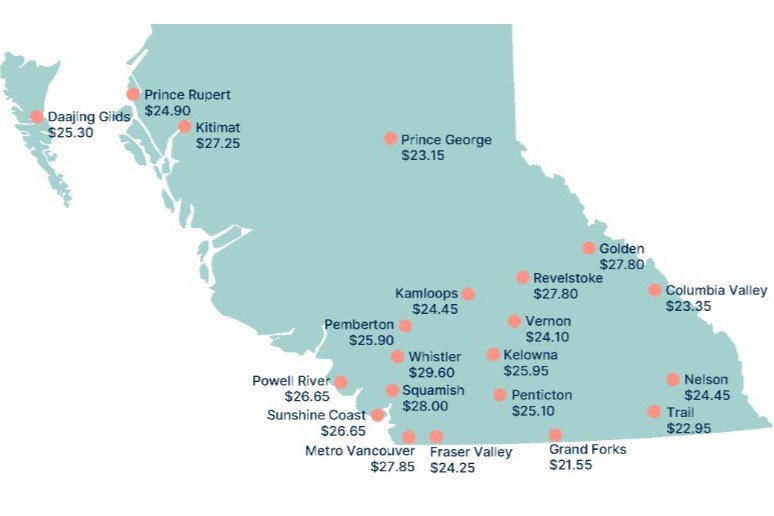Business
Prince George Living Wage Rises to $23.15; Experts Warn It’s Insufficient

The living wage in Prince George has increased by one per cent, reaching a total of $23.15 per hour, according to a recent report from Living Wage BC. This figure exceeds British Columbia’s minimum wage by $5.30, highlighting the ongoing struggle for many residents to meet basic living expenses.
The report, developed in collaboration with Integris Credit Union, takes into account essential costs such as housing, food, clothing, childcare, and transportation. It aims to provide a comprehensive understanding of the financial demands faced by households in the region. Notably, only 450 employers across the province currently offer employees the living wage, emphasizing a significant gap between the legal minimum and the amount deemed necessary for a basic standard of living.
Calculating the Living Wage in Prince George
The methodology used to calculate the living wage includes various family types, including single adults, single parents with children, and families of four. The figures are weighted according to their prevalence in the population, resulting in a singular living wage figure for Prince George and the surrounding Cariboo region. While the report considers many expenses, it does not factor in retirement savings, student loans, or the costs associated with caring for elderly or disabled family members.
Anastasia French, managing director of Living Wage BC and co-author of the report, noted that while housing costs in Prince George may be lower than in other parts of the province, the overall cost of living remains high. “In Prince George, there needs to be more focus on lowering the cost of food,” French stated. She highlighted the added logistical challenges of food costs, given the city’s distance from Vancouver, which contributes to higher prices.
French also pointed out the limited public transportation options available, which can make owning a vehicle a necessity, further straining household budgets. Despite these challenges, she mentioned that Prince George ranks in the middle concerning living wages across British Columbia.
Challenges in Northern Communities
The situation in Prince George reflects broader challenges faced by other northern towns. A lack of affordable housing combined with increased industrial activity has driven living wages even higher in some regions. French provided examples of Prince Rupert and Kitimat, where living wages have soared above $27 per hour due to rising housing costs and food prices.
French emphasized the significant impact that living below the established living wage can have on individuals’ overall well-being. She cited research that connects poverty with both physical and mental health challenges. “Living in poverty can affect your physical health and your mental health,” she explained.
Through focus groups with low-wage workers, the study revealed that high food costs make daily decisions particularly stressful. “When you’re hungry, you’re more stressed,” French remarked, illustrating how financial strain can influence relationships and overall quality of life.
As Prince George navigates its economic landscape, the findings from Living Wage BC underscore the urgent need for action on housing and childcare, which could help lower the living wage in the future. For more information on the report and its findings, visit Living Wage BC‘s official website.
-

 Politics2 weeks ago
Politics2 weeks agoSecwepemc First Nation Seeks Aboriginal Title Over Kamloops Area
-

 World4 months ago
World4 months agoScientists Unearth Ancient Antarctic Ice to Unlock Climate Secrets
-

 Entertainment4 months ago
Entertainment4 months agoTrump and McCormick to Announce $70 Billion Energy Investments
-

 Lifestyle4 months ago
Lifestyle4 months agoTransLink Launches Food Truck Program to Boost Revenue in Vancouver
-

 Science4 months ago
Science4 months agoFour Astronauts Return to Earth After International Space Station Mission
-

 Technology3 months ago
Technology3 months agoApple Notes Enhances Functionality with Markdown Support in macOS 26
-

 Top Stories1 month ago
Top Stories1 month agoUrgent Update: Fatal Crash on Highway 99 Claims Life of Pitt Meadows Man
-

 Sports4 months ago
Sports4 months agoSearch Underway for Missing Hunter Amid Hokkaido Bear Emergency
-

 Politics3 months ago
Politics3 months agoUkrainian Tennis Star Elina Svitolina Faces Death Threats Online
-

 Politics4 months ago
Politics4 months agoCarney Engages First Nations Leaders at Development Law Summit
-

 Technology4 months ago
Technology4 months agoFrosthaven Launches Early Access on July 31, 2025
-

 Lifestyle2 months ago
Lifestyle2 months agoManitoba’s Burger Champion Shines Again Amid Dining Innovations



















